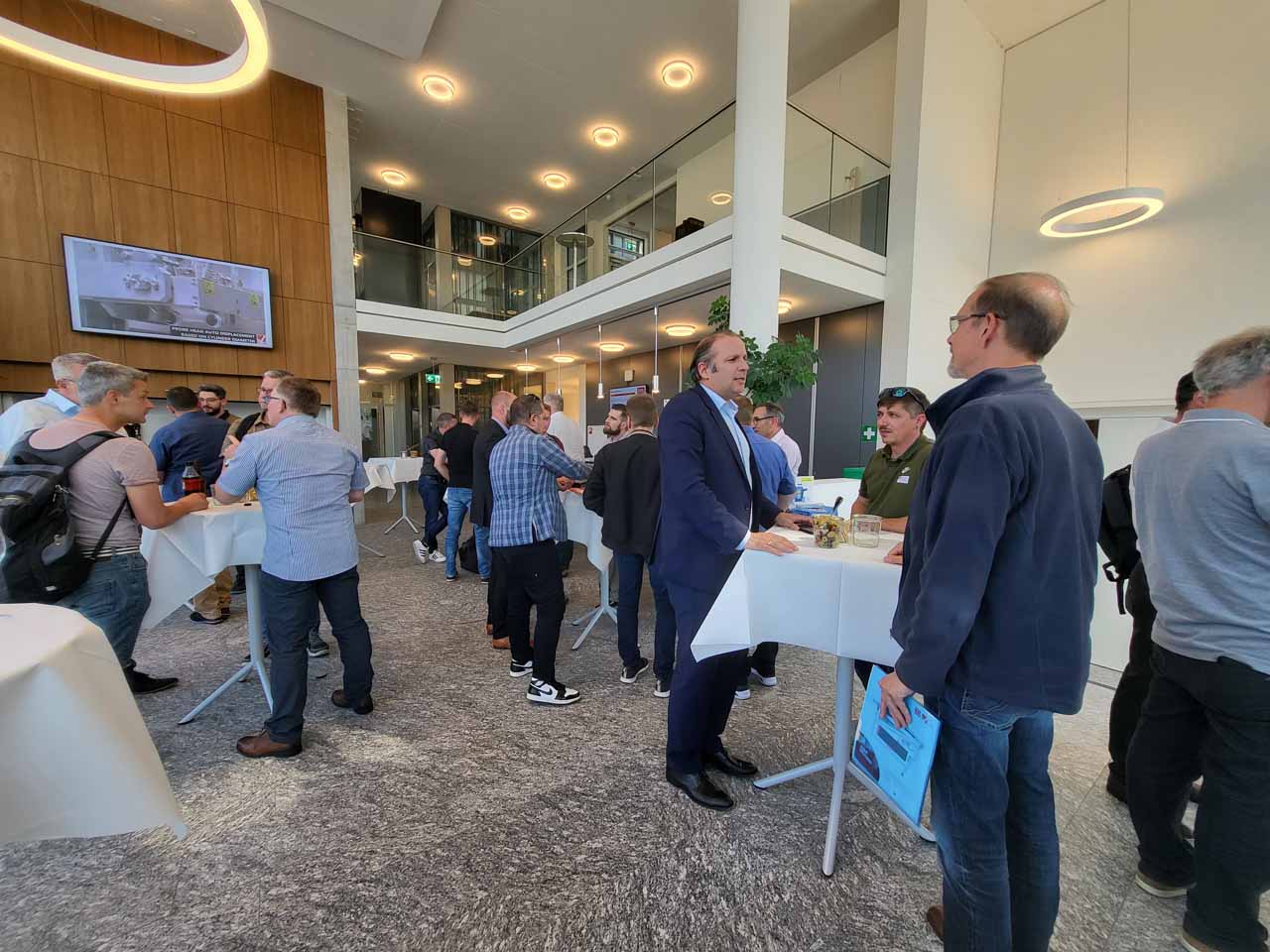Second Swiss Elevator Day
Aug 5, 2023

Gathering provides a compact interconnection of expertise and contacts.
Following the first event in 2021, approximately 80 participants met on June 6 at the Swiss Safety Center Academy of the Swiss Association for Technical Inspections (Schweizerischer Verein für technische Inspektionen [SVTI]) in Wallisellen near Zurich, Switzerland, for the Second Swiss Elevator Day under the motto “Trends, Innovations, Things to Know.” The beautiful, new, bright premises with good facilities for events was easy to reach. The venue is located directly behind the Wallisellen train station, only a few stops away from the airport and the main train station of Zurich. The audience consisted mainly of representatives of installation companies and planning offices or operators of elevators and passenger transportation systems.
In six presentations — some intensively discussed — in just one day, compact information was provided on current topics from the elevator industry with Swiss highlights. Often outdoors in beautiful summer weather, many long breaks and the “Aperó” afterward provided ample opportunity to exchange views on current developments and gather new ideas for one’s own activities. Most participants spoke Swiss/German with each other, but with consideration from both sides (Swiss and Germans), no content was lost in translation.
Welcoming and Closing Words, and the Swiss Elevator Market, Thomas Zimmer, SVTI
Thomas Zimmer, head of the Federal Elevator Inspectorate based at the SVTI, welcomed attendees and closed the conference. As conference chair, he also led the program of presentations he had arranged. At the beginning of the conference, Zimmer also presented key figures on the Swiss elevator market:
Forty installers contributed to these reports, including seven that install more than 100 elevators per year, which, in total, corresponds to approximately 7,600 elevators — roughly 95% of all reports. The figures per canton can be found at svti.ch. No figures exist for modernizations, as these are not mandatory to report in Switzerland.
SVTI Group, Raffael Schubiger, SVTI
Raffael Schubiger, director of SVTI, presented a report on the association and its services. SVTI considers itself the Swiss competence center for technical safety and risk management. In 2022, it ranked ninth in the Swiss Employer Award. Ninety employees generate turnover of CHF19 million (US$21 million). The private-law, independent, non-profit association with approximately 8,000 members was founded in 1869 as the Swiss Association of Steam Boiler Owners (Schweizerischer Verein von Dampfkessel-Besitzern [SVDB]) on a voluntary basis as a self-help organization. Today, it performs official and private tasks on behalf of the federal government and the cantons.
The purpose of the SVTI is to prevent accidents, failures and damages, as well as eliminate hazards in the manufacture and operation of technical systems of all kinds. Its main activities are the safety of stationary pressure equipment and systems, monitoring of technical systems and equipment such as pipes and pipelines, installations in power plants and pressurized vessels and market surveillance for elevators and pressure equipment.
“Digitization in Elevator Construction — Will the Service Technician Become Obsolete?” Tim Ebeling, Henning
Ebeling addressed four key issues in his presentation:
- Directives and standards on digitalization. ISO 8102-20 “Electrical requirements for lifts, escalators and moving walks — cybersecurity” has an impact on almost every electronic component. The code describes the requirements for new certifications. Implementation starts even before the development of a component. European harmonization is underway. Singapore is miles ahead of Germany and Switzerland, mainly because of an even more severe shortage of personnel there. Until now, elevators there had to be serviced once a month. The Code of Practice of the Building & Construction Authority of Singapore, “Remote Monitoring & Diagnostics (RM&D) for Lifts,” has just been published. If a monitoring system is certified according to this code, the frequency of servicing can be extended. This means that no one is put out of work; it simply ensures that all the necessary services can be carried out. “The EU Data Act is madness,” Ebeling observed. He assessed “The Path to the Digital Decade” of the EU Commission. “Tomorrow, the user could request that a repair service, which may be cheaper, also gets access to the data” free of charge. Although this applies to all industries, it runs contrary to aspirations in elevator construction.
- Digital (system) communication. Digital solutions will dominate communication among stakeholders. Various players on the market will offer diverse services. A new feature is elevator management via a provider/broker that monitors service companies with digital solutions and reports to operators/managers.
- Effects of digitalization. Especially in maintenance/service, new players will emerge, such as specialized Internet of Things (IoT) companies from other industries whose appetite has been roused. For example, Digital Spine’s Aufzugshelden (elevator hero) box promises to increase elevator availability and save costs.
- Digital maintenance. Current maintenance strategies are time-based, e.g., monthly, or usage-based, e.g., every 20,000 trips. The technician comes too often doing too much work to maintain the referenced condition and avoid the failure threshold.
Preventive maintenance: IoT solutions are used, e.g., for trip counters or remote access. Machine learning and Big Data evaluations enable new insights. Condition-based maintenance is wear-based (predictive) and enables continuous system improvement (proactive). One approaches the failure threshold without more failures, but with fewer people and fewer deployments. Such a solution is provided by Henning’s WEARwatcher condition monitoring system, which works with all systems and is currently being rolled out with 10,000 assets in Singapore. Ebeling ended his presentation by expressing the hope that, in the future, everyone will seek a common solution. The European Telecommunications Standards Institute is already working towards this goal.
“BIM at the Swiss Federal Railways,” Adrian Wildenauer, Schweizer Bundesbahnen SBB
Wildenauer first mentioned key figures of SBB (Swiss Federal Railways):
- 93.6% of trains are on time.
- There are 11,338 trains per day. They call at 806 stations (806 stops).
- 1.16 million passengers and 180,000 net tonnage of goods are transported per day.
- This requires eight hydroelectric power plants, 2,500 buildings, 12 maintenance facilities, 4,927 bridges, 36,282 signals, 3,265 km of track and 310 tunnels, which are planned, built, and operated at a cost of approximately CHF2.2 billion (US$2.45 billion) per year.
Digital solutions will dominate communication between stakeholders.
The mission that led to the use of Building Information Modeling (BIM) was intended to make the railroad more connected, powerful, efficient, cost effective and customer-friendly. As a first step on the way to BIM, an analysis of business and IT processes was carried out. Achieving the goal is only possible with stable operations based on resilient data across the entire lifecycle of all buildings and facilities. The resulting roadmap gave the go-ahead for properties in 2021 and for infrastructure including supporting facilities, such as energy and telecom, in 2025. This development is monitored by the controlling department.
To determine the value chains, a process analysis was also prepared. This revealed an enormous need for information. For example, 2,000 construction projects per year lead to approximately 2 million interactions of all participants per week, which results in about 10 million deliverables per year in the form of calculations, files, protocols and the like. In addition, the interactions are growing exponentially.

The realization was quickly made that introducing new methods like BIM into existing organizations doesn’t work. That’s why SBB has been talking with all educational institutions for five years to facilitate change for people.
The business-use case was then created from the combination of the four components of capability + processes + data + technology. Wildenauer summarized the current status in four topic blocks:
- Model-based communication and coordination – just under 100%
- Model- and platform-based quality management and approvals – approximately 80%
- Model-based construction phase planning – approximately 50%
- Model-based cost determination and monitoring – approximately 20%
BIM implementation in the SBB infrastructure will then be realized in five stages from mid-2024 to 2033. In the end, all projects that were tendered with BIM will also be completed with BIM.
In conclusion, Wildenauer formulated his wish that, in such a comprehensive change, everyone should focus on — among other things — common, reliable, relevant content; commonalities between buildings and their infrastructure; simple, user-centric technology; and employee competencies. His appeal: “Just do BIM, but with a changed culture of failure!”
“Functional Safety/E-Safety for Elevators,” Rudolf Ramseier and Hermann Gehrig, Cobianchi Liftteile, with Stephan Rohr, ELGO Batscale
Ramseier began by presenting the history of Cobianchi, including its two test towers for free-fall tests. The goal of the cooperation with ELGO is to achieve as many interfaces as possible between sensors/actuators and performance. He described the result of the joint development as an “electronic image of a speed limiter,” where the deviation of a signal leads to a signal where something happens. He expects 5% of the remaining work to be completed in the next five weeks. There is still discussion about whether one or three certificates are needed to introduce this technology into the market.
Rohr started by presenting the history of ELGO Batscale in Liechtenstein, Switzerland and Germany with two R&D sites in Berlin and Dortmund, both in Germany. Tools offered by ELGO include a configurator and a customer hub.
This was followed by a product overview of the Limax series. Rohr was keen to emphasize that the new 2CP, 3CP and 2RED versions meet SIL3 with a 900-g sensor, 18 components IP 54/55 and no cables on the device. Coated circuit boards add to the 20-year durability. Functional scopes vary and generally include safety circuits, door contacts, eSGC and dynamic functions. He also presented the SGA, the release unit for mechanical safety gears with a pull force on release of 400 N and a reset force > 400 N, which is combined with Limax. The box is mounted, for example, underneath the cabin.
Machine learning and Big Data evaluations enable new insights.
Gehrig of Cobianchi, as the third speaker on this topic, dealt with:
- Requirements for electrically triggered safety gears: Among other things, they must be universally applicable, have a short reaction time, reset themselves without car movement, have a double effect with regard to UCM (unintended car movement), have an EU-type examination certificate, have low energy requirements, have few interfaces and be easy to install.
- Two design solutions for release unit respective safety gear
- EU-type examinations for sensor and for safety gear and superordinate for electrically triggered safety gear: It is not easy to get an examination because the EU Lift Directive (LD) does not mention overall system testing — only triggering and braking. Open, but clearly defined, interfaces remain. In addition, the LD does not clearly define the electrically triggered safety gear as a safety component, so even here, despite testing, permissibility is generally doubted in discussions. Although an attempt has been made to simplify precisely this, the standards have yet to be revised accordingly. The product will go to market like this anyway. How the market receives it remains to be seen.
- Structure and function of the main components with three operating positions (home position for normal operation, standby position for power-saving mode and end position for braking) and three operating modes (reset, self-monitoring power-saving mode).
- Advantages: The mechanical components and electrical monitoring switch are eliminated. Assembly results in time savings and fewer errors. Service is easier. There are diagnostic possibilities, e.g., via log-files.
After his presentation, Gehrig also answered participant questions concerning his exhibit directly in the front of the conference room.
The Next Swiss Elevator Day
The next Swiss Elevator Day will take place on May 20, 2025, again in Wallisellen.
“EN Elevator Standards and VSA Guide for Modernization (Development of EN ISO 8100-1/-2),” René Hermann, Association of Swiss Elevator Companies (Verband Schweizerischer Aufzugsunternehmen [VSA])
Hermann has been the convenor of WG1 CEN TC 10 since 2020 and is a member of the International Organization for Standardization (ISO) TC 178. In a panel, he presented the current status of the EN 81 family. Parts EN 81-20/-50 will be replaced by EN ISO 8100-1/-2. Among other things, this will create the same safety standards throughout Europe and worldwide, avoid duplication of work on standards and split the work between CEN and ISO. This procedure was already agreed upon in the Vienna Agreement in 1991. During this, EN 81-20/-50 is adapted to the state of the art and the legal concerns of the EU Commission are taken into account.
In the following, Hermann listed in extracts what is likely to change during the transition:
- Structure and content according to CEN/ISO rules
- New suspensions
- Traction sheave elevators with increased effective area
- Requirements for machine brakes
- Safe access to the shaft pit
- Retracting hands in doors
- SIL (Safety Integrity Level)-rated safety circuits replacing PESSRAL (Programmable Electronic System in Safety Related Applications for Lifts)
- Automatic rescue systems
- Service platforms in the shaft pit
- Vertical doors
- Structure of the standard
- Some titles from single parts of the standard
The schedule includes the following key figures: Working Drafts (WD) are available. Translations are in progress. In Q2 2023, he expects the enquiry and, in Q2 2024, the final vote, so that, in Q1 2025, the two parts could be ready.
Simultaneously, 14 parts of the 81-series standards still need to be harmonized. The new EU Machinery Regulation also must be considered. Hermann asks critically whether there is sufficient expertise for all these tasks, which standards are absolutely necessary for the industry and which ones need to be harmonized.
“Hydraulic Elevators from 320 kg (705 lbs) to 12,000 kg (25.500 lbs): Calculation of Payload, Planning and Visualization by Means of an Online Configurator,” Harald Giehl, ALGI Alfred Giehl
Giehl started his presentation with a company history. Using screenshots, he presented the ALGI configurator at algionline.com, which was launched half a year ago. The layout takes about 30 min. Many visitors took the opportunity to ask for details about the configurator at the roll-up in front of the lecture hall.
Among other things, drive components can be taken into account, subdivided into individual hydraulic components, respective kits or complete elevators. The next step is to design the lifter and power unit. For four weeks, the new Smart Pack (hydraulic drive from ALGI with NEW LIFT control), in which all sensor cables are of plug-in design, has also been integrated.
BIM implementation in the SBB infrastructure will be realized in five stages from mid-2024 to 2033.
In the kit or complete elevator path, the focus is initially on the car with its data and dimensions. Payload, speed and the layout of the doors are also considered. After further steps, the computer provides a preview and offers the option of requesting a quotation straight away. Free of charge and independently of the order, a shaft drawing is always sent to the potential customer, as is the car with walls, floor and ceiling.

“The New European Machinery Regulation,” Franziska Slongo, Swiss State Secretariat for Economic Affairs (Staatssekretariat für Wirtschaft [SECO])
The revision of the EU Machinery Directive 2006/32 (MD) became necessary to cover new risks from new technologies such as AI and cybersecurity. At the same time, it is intended to improve safety for conventional machines. There is a need for clarification on the wording “significant design change” and adaptation in Annex IV. It overlaps with other EU legislation and needs to be reduced. Alignment with the new EU Legislative Framework (NLF) is necessary. The differing implementations of the MD in EU member states must be synchronized.
On April 21, 2021, the EU Commission presented its proposal. After various intermediate steps, it is expected to be published in July 2023. The text is available at europarl.europa.eu/doceo/document/TA-9-2023-0097_EN.html. The link for German translation is europarl.europa.eu/doceo/document/TA-9-2023-0097_DE.html. The effective date is expected to be January 2027. Implementation in Switzerland will be simultaneous and equivalent. There will be no parallel application of the previous MD and the new European Machinery Regulation (MR), which will be ensured by a long transition period of 42 months.
The new European MR contains nine chapters and 12 annexes. According to Article 2, its scope includes machinery, associated products such as safety components and ropes/belts, as well as partly completed machinery. It does not apply to means of transport in the air, on water and on rail networks, or to electrical/electronic products with WLAN functions, other than 3D printers. Article 3 defines — among other things — terms such as machine, safety component, safety function and, in paragraph 16, “significant design change.” New features include enabling or taking into account digital operating instructions, cybersecurity and AI. The conformity assessment procedure also changes.
Slongo concluded that the new MR covers many of the objectives mentioned at the beginning. It enables “safe machines with, or despite, AI!”
Get more of Elevator World. Sign up for our free e-newsletter.













